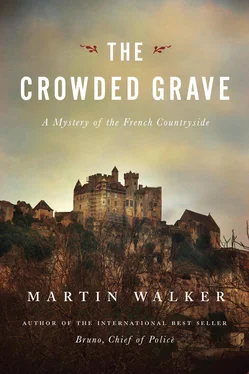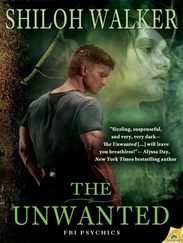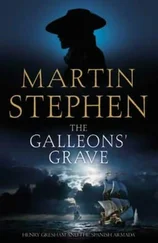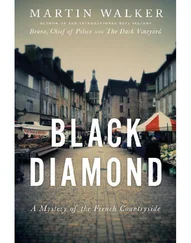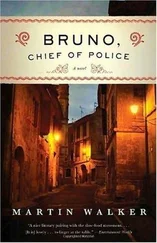Martin Walker - The Crowded Grave
Здесь есть возможность читать онлайн «Martin Walker - The Crowded Grave» весь текст электронной книги совершенно бесплатно (целиком полную версию без сокращений). В некоторых случаях можно слушать аудио, скачать через торрент в формате fb2 и присутствует краткое содержание. Жанр: Полицейский детектив, на английском языке. Описание произведения, (предисловие) а так же отзывы посетителей доступны на портале библиотеки ЛибКат.
- Название:The Crowded Grave
- Автор:
- Жанр:
- Год:неизвестен
- ISBN:нет данных
- Рейтинг книги:5 / 5. Голосов: 1
-
Избранное:Добавить в избранное
- Отзывы:
-
Ваша оценка:
- 100
- 1
- 2
- 3
- 4
- 5
The Crowded Grave: краткое содержание, описание и аннотация
Предлагаем к чтению аннотацию, описание, краткое содержание или предисловие (зависит от того, что написал сам автор книги «The Crowded Grave»). Если вы не нашли необходимую информацию о книге — напишите в комментариях, мы постараемся отыскать её.
The Crowded Grave — читать онлайн бесплатно полную книгу (весь текст) целиком
Ниже представлен текст книги, разбитый по страницам. Система сохранения места последней прочитанной страницы, позволяет с удобством читать онлайн бесплатно книгу «The Crowded Grave», без необходимости каждый раз заново искать на чём Вы остановились. Поставьте закладку, и сможете в любой момент перейти на страницу, на которой закончили чтение.
Интервал:
Закладка:
“A camera won’t do any good,” said Alain. “Even with photos the damn courts will take their side. They’re all mad Greenies, the magistrates. Then there’s those food inspectors and all the other rules and regulations, tying us up in knots.”
“I think I know who it is,” said Sandrine. “It’s those students at the archaeology site who came in last week, working on some dig with that German professor, over toward Campagne. They’re all staying at the municipal campground. This time of year, they’re the only strangers around here and you know what those students are like. They’re all Greens now.”
Bruno nodded. “I’ll check it out. See you later.” Along the fence he saw the fluttering of another of the leaflets inside a plastic bag, one of the kind that could be sealed and used in freezers. He took out a handkerchief and gingerly removed the pins that held it to the wire. Forensics might get something from it. There were several more attached along the fence and he took another. He nodded at Alain. “Do you want to come with me? You’ll have to move your tractor.”
As he reached the road, where the jam was steadily clearing itself, Bruno’s phone rang again. He checked the screen, saw the name “Horst,” and this time he answered. Horst Vogelstern was the German professor of archaeology in charge of the student volunteers at the dig. For more than twenty years Horst had spent his vacations at a small house he owned on the outskirts of St. Denis. He ran digs in the Vezere Valley that the local tourist board liked to proclaim as the cradle of prehistoric man. The first site of Cro-Magnon man had been found in the valley over a hundred years earlier, and the famous cave paintings of Lascaux were farther up the river. It was a source of pride to Bruno that he lived in this valley that could claim the longest continuous human habitation of anywhere on earth.
Bruno had attended a couple of Horst’s lectures, delivered in excellent if strongly accented French. He had visited his digs and read a couple of articles Horst had published in the popular monthly Dossiers d’Archeologie. Normally a quiet man, Horst became passionate when he talked of his subject, the great mystery of the replacement of the Neanderthals by the Cro-Magnons some thirty thousand years ago. Had it been violent? Did they interbreed? Were the Neanderthals wiped out by some plague or disease? It was, said Horst, the crucial question regarding our human origins. Whenever Horst spoke, Bruno caught a sense of the excitement that gripped the scholar.
“Horst,” he answered. “How are you? I was just on my way to see you at the dig.”
“Good, we need you here right away. And you had better bring a doctor with you. We’ve found a body.”
“Congratulations. Isn’t that what you wanted to find?”
“Yes, yes, but I want skeletons from the distant past. This one is wearing a St. Christopher medal around his neck and I think he’s also wearing a Swatch. This is your department, Bruno, not mine.”
2
As Horst led Bruno past the parallel trenches and the chessboard pattern of white string that defined the work of the site, Bruno was struck as always by the careful dedication of the archaeological team. Using fine brushes to tease away the soil from a possible find and sifting each handful of earth through a sieve, they barely looked up as he passed. Some of them were in trenches so deep that he had to peer down to see them, provoking them to look up as his body blocked what little sunlight they had.
He heard a shout. “Bruno!” He turned to see a pretty girl with fair hair and a slim build jumping across the trenches toward him.
“Dominique,” he exclaimed, as he received the embrace of a young woman he had known since she was a child. Her father, Stephane, was one of Bruno’s regular hunting partners. He ran a small dairy farm in the hills and made the Tomme d’Audrix cheese that Bruno loved. Each winter since Bruno had arrived in St. Denis he had been invited to the killing of the family pig, and he and Dominique always had the job of rinsing out the intestines in the freezing water of the nearest stream. Now at the university in Grenoble, she was a militant but very realistic member of the Green Party. “I was coming up to the farm to see you. Your dad invited me to Sunday lunch.”
“You’re here for the body?” she said, hanging on to his arm.
“Right. I’d better get a look at it, but I’ll probably see you Sunday.”
“No, I’ll see you tonight at the museum. You have to come to the professor’s lecture. It’s a big announcement, but we’re all sworn to secrecy.”
She darted off, leaving Bruno to cast his eyes over the site. Close to the overhang of rock, the trenches gave way to a large pit, at least twelve feet square and nine feet deep, with metal ladders propped against the sides. At the bottom, a large flat rock with curious cup-shaped holes in its surface was being worked on by three archaeologists. They were using brushes so fine they could have belonged to portrait painters. Even from this height, Bruno could see the brown smoothness of newly exposed bones. He looked inquiringly at Horst, assuming this was the skeleton that had prompted the call. The people working with the brushes did not look up. Their continued concentration struck him as even more remarkable, given the ghoulish nature of the discovery. Maybe archaeologists were accustomed to bones and death.
“Sorry this grave is so crowded, but your body is this way, to the side of the main dig,” said Horst. His beard was a little whiter than the previous year, his hair more sparse, and he was still wearing the English tweed jacket with the leather elbow patches that Bruno remembered from last year and many years before. “Those bones down there are from three bodies over thirty thousand years old. Your skeleton is over here.”
Steering Bruno past a small winch with a system of pulleys attached to a tripod, Horst led Bruno across to a long, narrow trench, perhaps six feet deep. Beside it an attractive girl and an older woman with red hair, wearing what Bruno thought was a man’s shirt in green and white stripes, were standing to watch their approach.
The girl, her glossy dark hair tied in a loose bun held together by what looked like an antique TV antenna, had a hand on the shoulder of a burly young man with long hair. He was kneeling, head bowed over the trench. A small trowel lay beside him. The red-haired woman smiled politely as Bruno approached. It was one of those delicate moments of French meetings; he wasn’t sure he knew her well enough for the bise, the kissing of cheeks.
“Bonjour, Clothilde,” said Bruno, opting for the handshake. She was director of one of the departments of the National Museum of Prehistory in Les Eyzies. She used his outstretched hand to pull him forward to exchange kisses in a determined way, as if to declare that no mere corpse was going to deter her from the social niceties. One of the most eminent archaeologists in France, Clothilde Daunier was friend and colleague to Horst and they had once been lovers. Over a bottle of German wine he had brought as a gift to Bruno, Horst had once confided that Clothilde had been the love of his life, though their affair was said to be long over. Bruno wasn’t so sure; he distinctly remembered seeing Horst in the green and white shirt Clothilde was wearing.
“Bruno, this young lady is Kajte, from Holland, and I hope I pronounced that correctly,” Clothilde said. The girl gave her a cool smile and proffered a hand for Bruno to shake. She looked like a self-confident young woman, her gray eyes appraising him with a raking glance. Even though she wore the khaki slacks and denim shirt that was almost a uniform among the students on the dig, hers looked expensive. Maybe it was the way she wore them. “And this is Teddy who found the body. He’s British, and he’s understandably somewhat upset.”
Читать дальшеИнтервал:
Закладка:
Похожие книги на «The Crowded Grave»
Представляем Вашему вниманию похожие книги на «The Crowded Grave» списком для выбора. Мы отобрали схожую по названию и смыслу литературу в надежде предоставить читателям больше вариантов отыскать новые, интересные, ещё непрочитанные произведения.
Обсуждение, отзывы о книге «The Crowded Grave» и просто собственные мнения читателей. Оставьте ваши комментарии, напишите, что Вы думаете о произведении, его смысле или главных героях. Укажите что конкретно понравилось, а что нет, и почему Вы так считаете.
